One of the most affordable ways to solve the issue of arranging an autonomous sewage system is to build a septic tank with your own hands. The cleaning concrete structure, made of two compartments, will make it possible, with a small material investment, to solve the issue of drainage. On what principle the structure functions and how to build a two-chamber septic tank from concrete rings, we will consider in the article.
The septic tank, consisting of two chambers, is a practical sewage treatment plant capable of processing organic waste.
The cleaning mechanism is based on the operation of two communicating compartments, inside of which the liquid component and the insoluble solid component are separated by settling.
The scheme of functioning of a two-chamber septic tank is as follows: sewage drains first enter the first compartment, and after settling in the first chamber, the liquid component flows into the absorption well, from which it is discharged through a ground filter into the underlying layer
Each compartment of a two-chamber structure is responsible for certain tasks:
- First camera... Receives drains from the inlet sewer pipe coming from the house. Inside the chamber, the drains settle, as a result of which the solid fractions sink to the bottom, and the clarified waste flows through the overflow pipe into the second compartment. Sludge accumulating at the bottom must be pumped out periodically.
- Second chamber. Responsible for the final disposal of clarified settled effluent. Passing through a ground filter, the thickness of which is 1 m, the wastewater is purified to the extent that it allows it to flow freely into the environment without the threat of disrupting the natural balance.
Additional cleaning inside the second chamber is achieved with a crushed stone or gravel filter. It prevents the penetration of insoluble inclusions into the soil layers. The clarified wastewater that has undergone such treatment significantly reduces the total volume of the sewage mass, which makes it possible to call the sewer workers much less often to empty the autonomous sewage facilities.
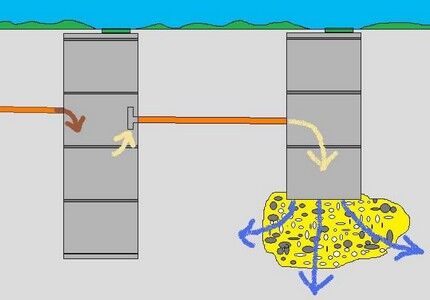
Purified and clarified water seeping through the filtration materials penetrates into the underlying soil layers. There must be at least 1 meter of soil between the groundwater level and the conditional bottom of the absorption well
Often, instead of filtration wells, filtration fields are placed. They represent several parallel trenches, the bottom of which is covered with crushed stone-sand filling. Pipes with perforated walls are laid on top of the filtration bed. The entire structure is covered with gravel and sand and covered with soil.
Application of concrete rings: pros and cons
The main thing that "bribes" septic tanks made of concrete rings is an affordable cost with high operating parameters. After all, reinforced concrete is rightfully considered one of the most durable materials.
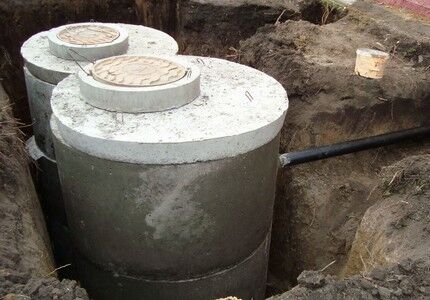
Septic tanks made of concrete rings are famous for their reliability and durability; a well-built structure is highly durable
Among the undeniable advantages of concrete septic tanks, consisting of two compartments, it is worth highlighting:
- Resistance to ground movements, abrupt volley discharges of sewage and aggressive effects of the sewer environment.
- The ability to process cubic meters of sewage. In the process of multi-stage treatment, the bulk of the effluent is removed in the form of a clarified liquid outside the structure. At the bottom, only a small part of the sludge settles, formed as a result of the processing of the organic component by bacteria that are always present in the sewer masses.
- Ease of operation and maintenance. It is only necessary to attract flushers to clean the walls of a spacious structure from layers of deposits only once every two to three years.
- Long service life. The service life of concrete rings can be more than half a century, and with proper care, even longer.
Treatment facilities made of concrete rings will not "float" to the surface under the influence of frost heaving of soils, as is often the case with lightweight tanks.
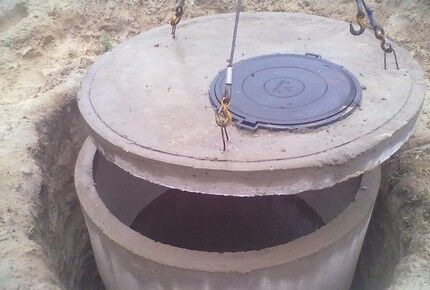
To be able to control the operation of the purifier, pump out the contents in a timely manner and, if necessary, carry out repair work, each compartment is equipped with a separate hatch
But this design also has its drawbacks:
- The need for involvement in the installation of construction equipment. It is almost impossible to deliver heavy rings to the site and immerse them in a pit without the use of construction equipment.
- Allocation of a large territory for its arrangement, which is not always possible in small areas.
Reservoirs made of concrete rings may lose their tightness during operation. The reason for the depressurization of the structure can be the appearance of cracks and leaks at the joints of the elements.

The owner's task is to periodically check the inner walls of the tanks for cracks, and the joints for leaks and, if necessary, eliminate defects.
Among the "minuses" of the structure, some users also highlight the moment that even with proper installation, an unpleasant smell exuded by the contents soars in the area of the septic tank. But this defect can be easily eliminated by using biological products that contain bacteria that process organic matter. They fix the problem easily, but do not damage the concrete surface and the sewer line.
How to calculate the volume of tanks
One of the key conditions for the smooth operation of a treatment plant is a competent calculation of its volume. To correctly calculate the volume of a septic tank, you need to focus on three parameters:
- The number of people who live in the house permanently.
- The total daily volume of sewage waste per person.
- The period of time during which organic substances have time to be completely processed.
When calculating, it is taken as a basis that the average daily volume of wastewater per household is 200 liters. And on average, it takes up to three days to process organic substances inside the treatment plant.
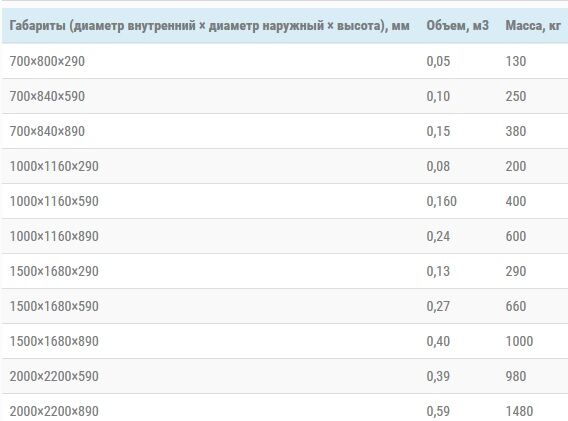
A dimensional table with marking of the produced reinforced concrete products with an indication of their diameter will simplify the calculation of the required number of elements
Knowing that there are up to 200 liters of wastewater per person per day, it is easy to calculate that the three-day volume of waste per household will be about 600 liters. The resulting value can only be multiplied by the number of family members permanently residing in the house.
When calculating, it is also worth taking an additional margin of 15-20%. It will allow you to avoid overflowing the norm in the event of a temporary increase in the number of household members and stay in the guest house for several days.
So for a family of four, a building with a capacity of 200 liters x 3 days will be required. x 4 people = 2.4 cubic meters We round off the resulting value and we find that for a family of 4 people, a septic tank with a capacity of 2.5-3 liters is required.
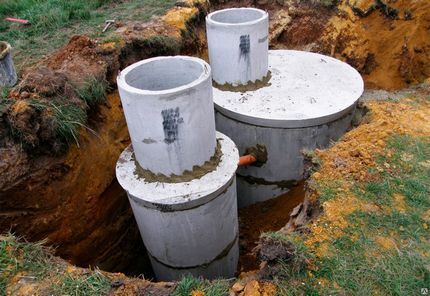
For areas that drain water well, it is worth choosing the option of arranging a septic tank, involving the removal of clarified liquid through the walls of the drainage compartment
If in the area where the mini-treatment plant is located there is a high level of groundwater occurrence, which can provoke a slowdown in the drainage process and even flooding of the structure, consider the option of arranging a septic tank that diverts wastewater to drainage fields.
Where to mark the treatment plant
When designing a treatment plant, the sanitary zone is located at a distance from significant objects on the site so that organic waste does not accidentally fall into the source of drinking water.
When choosing a place for the placement of a structure, they are guided by two standards: SNiP 2.-4.03.85 and SanPiN 2.2.1 / 2.1.1200-03. They spell out the rules for building external sewage structures and list the requirements for the arrangement of zones that can pose an environmental hazard to the environment.
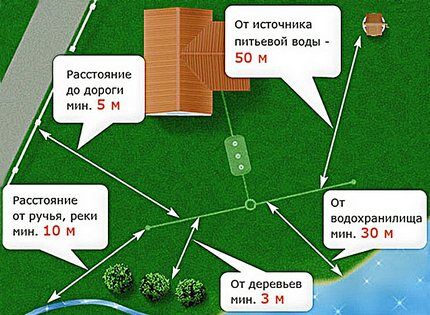
Observance of remoteness from significant objects is a guarantee that under-treated drains will not harm the environment
In the presence of nearby reservoirs with running water, the distance to them should be kept at least 20 meters. If there are plantings on the site, then the distance to trees should be about 3 meters, and shrubs - up to one meter.
When planning the arrangement of a sanitary zone, it is worth clarifying the place of laying the underground gas pipe in order to maintain a distance of 5 meters to it.
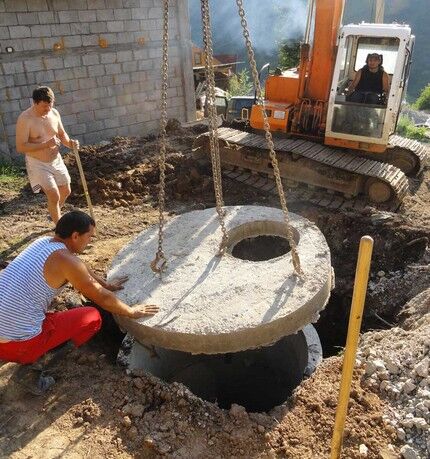
Of no small importance when choosing a place is the provision of conditions for free access to construction and sewage disposal equipment.
It is important to provide free space for access and maneuvering of construction and disposal equipment. At the same time, keep in mind that it cannot be placed directly above the place where the septic tank is buried, since a heavy machine is capable of destroying the walls of the treatment plant.
Septic tank installation technology
When installing a two-chamber septic tank made of concrete rings, be prepared for the fact that this is a rather difficult and painstaking work. To make it easier for yourself, use the services of special equipment or hire two or three assistants to perform the work.
It will be problematic for even several workers to lift a heavy ring. Well, installing it exactly in place is even more difficult.
Selection of materials and components
Concrete rings are available in the market in sizes. The height of the products is always the same and is 90 cm, but the diameter can vary from 70 to 200 cm. The volume of the ring directly depends on its diameter. So, a reinforced concrete ring with a section of 70 cm has a volume of 0.35 cubic meters. And the construction of tanks with a volume of 2.5 cubic meters will require 7-8 such rings.
If you use rings of 100 cm in size, each of which has a volume of 0.7 cubic meters, only 4 such rings will be required to build tanks of the same capacity.
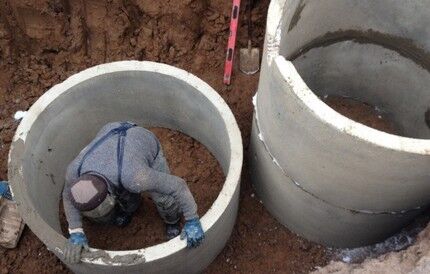
The most optimal option for the construction of a functional two-chamber septic tank is the use of concrete rings 100, 120 or 150 mm in size
The price of a product depends on its size. Therefore, in order not to miscalculate, before buying rings, always calculate the total volume and the required amount.
When calculating the capacity of a treatment plant and choosing rings for its construction, keep in mind that the actual volume of the tank must be higher than the calculated one. This is due to the fact that the liquid, as it is filled, will not be able to rise above the level of the overflow holes, which are placed 20-25 cm below the upper edge of the column.
When choosing rings of the required diameter, take into account the water table. The higher the underground waters are, the larger the rings should be. Indeed, as the diameter increases, their number decreases, and, consequently, the installation depth of the entire treatment plant also decreases.
Of the materials you will also need:
- pipes D110-120 mm;
- overflow tees;
- lime crushed stone of three different fractions;
- river sand.
The soil filter in the second chamber is formed from three layers of gravel or crushed stone, the size of the fraction of each underlying layer should be less than the fraction of the previous one.
In addition, you will need to stock up on liquid glass, cement for preparing a solution on the site and polyurethane foam to seal the joints.
Tools required for work:
- bayonet and shovel;
- building level;
- puncher;
- ladder;
- bucket with rope;
- mixing container;
- narrow spatula;
- wide brush.
For laying sewers to a septic tank and creating overflows, it is permissible to use polypropylene or asbestos-cement pipes.
Excavation works
The optimal period for starting excavation work is in the hottest weather or after the onset of the first frost, when the groundwater level is at its lowest.
For the arrangement of a two-chamber cleaner, it is better to dig a common pit for two wells at once. Although some experts are of the opinion that it is better to create two independent pits for each reservoir of the structure.
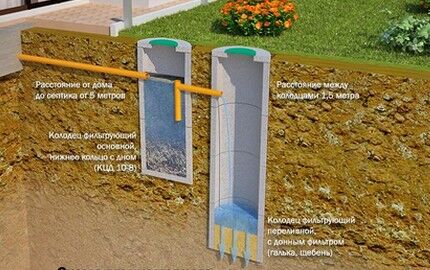
The reservoirs are installed at a distance of 1-1.5 diameters from each other so that the gap between them serves as a buffer at the time of ground movements
The dimensions of the pit are determined by the diameter of the selected rings. When calculating the dimensions of the pit, the following points should be taken into account:
- The depth of the product should be 30-40 cm lower than the height of the rings used. This is necessary in order to equip the dumping at the bottom or pour a concrete screed.
- The length and width of the pit should be such that the distance from the pit walls to the rings is at least 50-70 cm. This is necessary in order to simplify installation and to be able to waterproof the outer walls of the structure.
You can also dig a pit manually with a shovel, removing the soil with a bucket. But it is much easier to use special equipment for this, with the efforts of which it will not be difficult to dig a hole in just a few hours. In confined spaces, it is best to use a small excavator. It is better to remove the soil from the pit immediately outside the site using the same machine that brought the rings.
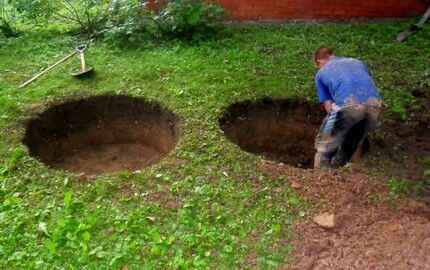
But even when using special equipment during excavation, you still have to work with your hands, leveling the walls and bottom of the pit
When creating a common pit for two tanks, the result should be a two-level pit so that the first compartment is half a meter deeper than the first.
At the same stage, trenches are laid under the sewer pipes. They are laid below the level of freezing of soil layers, which for regions of middle latitudes is about 1.2-1.5 meters.
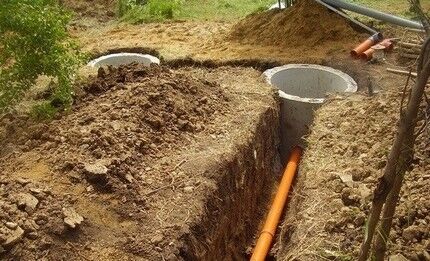
To ensure the gravity of the liquid when leading to the septic tank, the bottom of the trenches is made at a slope of 5 degrees, which is 20 mm for each running meter
The bottom of the trenches is leveled, guided by the building level, and tamped. The leveled base is covered with a layer of rubble or sand, on top of which the supply pipes are subsequently laid.
Pouring the base and erecting walls
The bottom of the dug pit is carefully leveled and tamped. The leveled base is covered with a sand layer, forming a "pillow" 15-20 cm thick. The formed dump is carefully tamped, creating a flat and free of drops surface.
To create a concrete base under the storage tank, the bottom of the pit is poured with cement mortar.
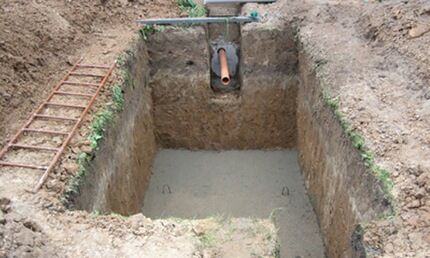
In order to increase the resistance of concrete to compression and bending, it is advisable to build a metal reinforcing frame when pouring the screed.
The size of the concrete screed should be 20-30 cm larger than the diameter of the rings used. It may take four or more weeks for the cement mortar to harden, depending on temperature and weather conditions. Only after that do they start installing the first ring.
To bypass the stage of pouring a concrete base and to make your work easier, it is better to use ready-made bottoms of sewer wells. They, like rings, are produced by precast factories.
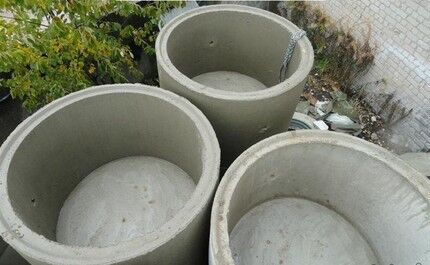
Rings with bottoms are structures, the upper part of which has a through hole, and the lower part is equipped with a blind bottom in the form of a circle
Using a crane, the first ring is installed in such a way that its walls are placed strictly vertically. This is necessary in order to ensure the stability and strength of the structure. The second is placed on top of it. Etc.
To increase the strength of fixation at the joints, metal brackets are mounted on the outside of the rings. The entry points are covered with concrete and sealed.
Waterproofing measures
To reduce the harm of groundwater impact on concrete, while protecting the structure from leaks, all joints between the bottom and walls from the inside should be sealed with cement mortar. Both the inner and outer walls of the tank are subject to processing.
To improve the water resistance of the composition and to accelerate its hardening, water glass is added to the solution. The main thing is to maintain a ratio of 25% when adding liquid glass to cement. If its share is exceeded, the glue can deteriorate the properties of the cement, increasing the risk of mortar hardening directly in the mixing container.
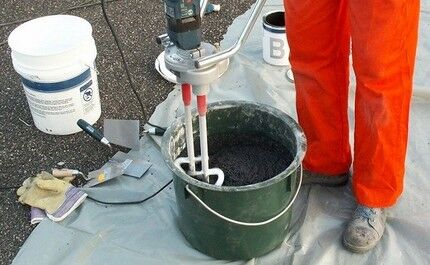
When preparing the composition, silicate is added to the ready-made mixture in small portions, continuously stirring the contents of the container
To increase the waterproof properties of the structure, the masters recommend using 2-3 types of waterproofing materials. For processing the walls of concrete elements, the following are used:
- deep penetration impregnation;
- bituminous waterproofing mastic.
The only condition is not to use toxic compounds that can kill the beneficial bacteria in the sump. For insulation from the outside, the surface is covered with bitumen mastic or roll material with a similar composition of derivatives.
A concrete cover with a hole is installed on top of the well, inside which a cast-iron hatch with a removable cover is mounted. To prevent freezing of the system, the upper part of the tanks is insulated with cuts of expanded polystyrene.
Features of creating a filtration compartment
The second well of the structure is built according to the same scheme. The only difference is the creation of a filter layer. It is laid at the bottom and along the walls of the tank. For this, the bottom of the dug pit is covered with:
- the first layer of sand - 10-15 cm thick;
- the second layer of fine crushed stone - 15-20 cm thick.
When forming a dump, it must be carefully compacted. To do this, the tamping of the "pillow" is alternated with filling it with water.
If lateral discharge of treated effluents is assumed, the walls of the absorption well are made of special perforated rings, the size of the holes of which is 30-50 cm.
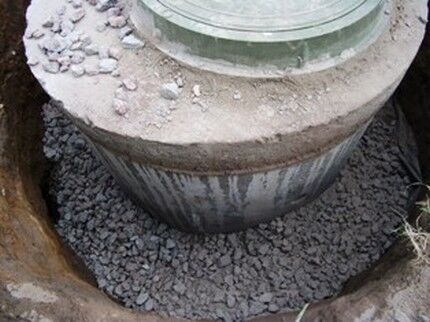
Crushed-stone-sand filling will ensure the immobility of the tank even at the moment of movement of the soil, when it "spree"
In the upper part of the tank, a neck with holes for a sewer hatch and a ventilation riser is installed. The vent pipe should be 70-80 cm above ground level.
To install the overflow pipe, a trench is dug between the tanks. The overflow is constructed in such a way that the difference in height between the entrance to the first compartment and the exit to the second tank is 15-20 cm.

The inlet and overflow pipes between the chambers should be equipped with tees that will prevent solid components from entering the second compartment.
It is easiest to make a hole in the tank wall for overflow with a perforator. Having led the edge of the pipe into the wall of the accumulator, it is fixed by blowing in with polyurethane foam. The cured foam will serve a dual purpose: acting as a damper pad and retaining moisture.
After making sure of the tightness of the structure, they begin to backfill it. For this, the voids between the outer surface of the well and the pit are covered with earth, previously mixed with sand. To create additional waterproofing, clay is used when backfilling.
An overview of one of the options for a two-chamber septic tank:
Secrets of correct installation:
How to build a septic tank at minimal cost:
In general, the installation of a two-chamber septic tank made of concrete rings, although troublesome, is quite a feasible task. The main thing is to take a responsible attitude to the choice of a place for its arrangement and strictly adhere to the installation technology. And then the treatment plant will regularly serve more than a dozen, making suburban life more comfortable.



